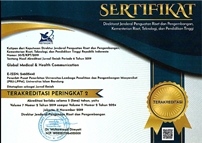Panoramic Radiography Measurements Not Correlated with BMD Results in End-stage Chronic Kidney Disease Patients
Abstract
Keywords
Full Text:
PDFReferences
Chen RT, Choi IGG, Munhoz L, Yasui EM, Iida CH, et al. Correlation between MCI/Sapori screening tools and DXA results and between MCI/Sapori and Frax tool for estimating fracture risk. Clin Lab Res Dent. 2019;2019:1–7.
Hsu CY, Chen LR, Chen KH. Osteoporosis in patients with chronic kidney diseases: a systemic review. Int J Mol Sci. 2020;21(18):6846.
Shevroja E, Cafarelli FP, Guglielmi G, Hans D. DXA parameters, trabecular bone score (TBS) and bone mineral density (BMD), in fracture risk prediction in endocrine-mediated secondary osteoporosis. Endocrine. 2021;74(1):20–8.
Kim K, Song SH, Kim IJ, Jeon YK. Is dual-energy absorptiometry accurate in the assessment of bone status of patients with chronic kidney disease? Osteoporos Int. 2021;32(9):1859–68.
Bajoria AA, Ml A, Kamath G, Babshet M, Patil P, Sukhija P. Evaluation of radiomorphometric indices in panoramic radiograph - a screening tool. Open Dent J. 2015;9:303–10.
AL-Suffar AB, Jameel NG. Correlation between the digital panoramic radiograph and DEXA examination as tools in the screening of osteoporosis in Iraqi postmenopausal women. J Res Med Dent Sci. 2023;11(1):69–75.
Lerner UH. Bone remodeling in post-menopausal osteoporosis. J Dent Res. 2006;85(7):584–95.
McNerny EMB, Nickolas TL. Bone quality in chronic kidney disease: definitions and diagnostics. Curr Osteoporos Rep. 2017;15(3):207–13.
Khaitan T, Shukla AK, Gupta P, Naik SR. Is panoramic mandibular index a reliable marker in the evaluation of bone mineral density and sexual dimorphism?? J Forensic Dent Sci. 2019;11(3):133–6.
Dagistan S, Miloglu O, Caglayan F. Changes in jawbones of male patients with chronic renal failure on digital panoramic radiographs. Eur J Dent. 2016;10(1):64–8.
Queiroz SM, Andrade ALDL, Oliveira PT, Leite Maia PR, Oliveira ÂGRDC, Almeida Freitas R, et al. Correlation of radiomorphometric indices of the mandible and biochemical parameters in patients with secondary hyperparathyroidism due to chronic kidney disease. Eur J Dent. 2019;13(3):303–9.
Redhu A, Suman B. Analysis of fractal dimension and radiomorphometric indices of mandible on panoramic radiographs in end-stage renal disease at a tertiary care centre in South India. J Indian Acad Oral Med Radiol. 2021;33(2):117–23.
Mohammed ARS, Hassan NA. Panoramic radiographic evaluation of the osseous morphological changes in Iraqi patients with chronic renal failure. TJDS. 2017;5(1):66–74.
Rupel K, Dal Broi C, Ottaviani G, Bellassai L, Bogdan Preda TM, Di Lenarda R, et al. Changes in mandibular radiomorphometric indices in osteoporosis patients treated with denosumab: a retrospective case-control study. BMC Oral Health. 2024;24(1):89.
Cardoso FB, Costa FW, Soares CE, de Moraes ME, D'alva CB, Cavalcante DS, et al. Oral health aspects in sporadic and familial primary hyperparathyroidism. J Clin Exp Dent. 2022;14(5):e396–403.
Göller Bulut D, Bayrak S, Uyeturk U, Ankarali H. Mandibular indexes and fractal properties on the panoramic radiographs of the patients using aromatase inhibitors. Br J Radiol. 2018;91(1091):20180442.
Moest T, Jahn AE, Heller K, Schiffer M, Adler W, Rohde M, et al. Peculiarities in the panoramic radiograph of patients with secondary hyperparathyroidism due to terminal renal disease: a radiologic controlled comparative study. Oral Radiol. 2023;39(1):125–32.
Shakibaei Z, Tohidi E, Gholyaf M, Garmrudi B, Garmrudi E. Dentomaxillofacial radiographic changes in a group of Iranian patients with end stage renal disease undergoing hemodialysis. J Dent Mater Tech. 2014;3(4):180–7.
Grocholewicz K, Janiszewska-Olszowska J, Aniko-Włodarczyk M, et al. Panoramic radiographs and quantitative ultrasound of the radius and phalanx III to assess bone mineral status in postmenopausal women. BMC Oral Health. 2018;18(1).
Drake MT, Clarke BL, Khosla S. Bisphosphonates: mechanism of action and role in clinical practice. Mayo Clin Proc. 2008;83(9):1032–45.
DOI: https://doi.org/10.29313/gmhc.v13i1.14182
pISSN 2301-9123 | eISSN 2460-5441
Visitor since 19 October 2016:
Global Medical and Health Communication is licensed under a Creative Commons Attribution-NonCommercial-ShareAlike 4.0 International License.
- https://jurnal.narotama.ac.id/
- https://www.spb.gba.gov.ar/campus/
- https://revistas.unsaac.edu.pe/
- https://proceeding.unmuhjember.ac.id/
- https://ejournal.uki.ac.id/
- https://random.polindra.ac.id/
- https://jurnal.politeknik-kebumen.ac.id/
- https://scholar.ummetro.ac.id/
- https://ejournal.uika-bogor.ac.id/
- https://journals.telkomuniversity.ac.id/
- https://www.iejee.com/
- https://e-journal.iainptk.ac.id/
- https://journal.stitpemalang.ac.id/
- https://revistas.unimagdalena.edu.co/
- https://catalogue.cc-trieves.fr/
- https://revistas.tec.ac.cr/
- https://jurnal.poltekapp.ac.id/
- https://ojs.adzkia.ac.id/
- https://journal.umpalopo.ac.id/
- https://journal.unifa.ac.id/































.png)
_(1).png)
_(1).jpg)
